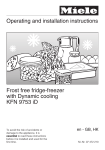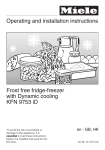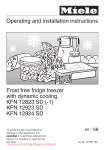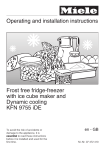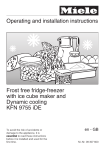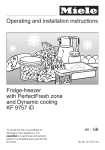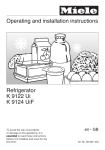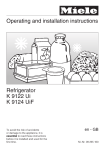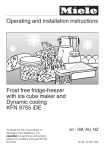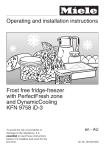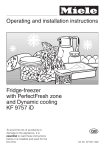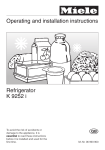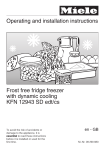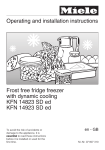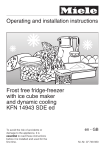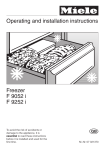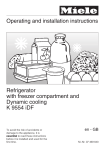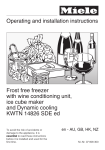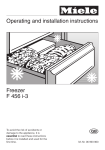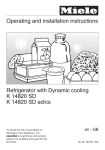Download Operating and installation instructions Frost free fridge
Transcript
Operating and installation instructions Frost free fridge-freezer with Dynamic cooling KFN 9753 iD To avoid the risk of accidents or damage to the appliance, it is essential to read these instructions before it is installed and used for the first time. en - GB, HK M.-Nr. 09 307 880 Contents Description of the appliance . . . . . . . . . . . . . . . . . . . . . . . . . . . . . . . . . . . . . . . . . 4 Caring for the environment . . . . . . . . . . . . . . . . . . . . . . . . . . . . . . . . . . . . . . . . . . 6 Warning and Safety instructions . . . . . . . . . . . . . . . . . . . . . . . . . . . . . . . . . . . . . 7 How to save energy . . . . . . . . . . . . . . . . . . . . . . . . . . . . . . . . . . . . . . . . . . . . . . . 12 Switching on and off . . . . . . . . . . . . . . . . . . . . . . . . . . . . . . . . . . . . . . . . . . . . . . 13 To switch the refrigerator section off separately. . . . . . . . . . . . . . . . . . . . . . . . 14 Safety lock . . . . . . . . . . . . . . . . . . . . . . . . . . . . . . . . . . . . . . . . . . . . . . . . . . . . . . . 14 Switching off for longer periods of time . . . . . . . . . . . . . . . . . . . . . . . . . . . . . . . . . 15 The correct temperature . . . . . . . . . . . . . . . . . . . . . . . . . . . . . . . . . . . . . . . . . . . 16 . . . for the refrigerator section . . . . . . . . . . . . . . . . . . . . . . . . . . . . . . . . . . . . . . . . 16 . . . in the freezer section . . . . . . . . . . . . . . . . . . . . . . . . . . . . . . . . . . . . . . . . . . . . 16 Setting the temperature in the refrigerator section / freezer section . . . . . . . . . . . 16 Temperature range . . . . . . . . . . . . . . . . . . . . . . . . . . . . . . . . . . . . . . . . . . . . . . 17 Temperature display . . . . . . . . . . . . . . . . . . . . . . . . . . . . . . . . . . . . . . . . . . . . . . . 17 Temperature display brightness. . . . . . . . . . . . . . . . . . . . . . . . . . . . . . . . . . . . 18 Alarm . . . . . . . . . . . . . . . . . . . . . . . . . . . . . . . . . . . . . . . . . . . . . . . . . . . . . . . . . . . 19 Temperature alarm . . . . . . . . . . . . . . . . . . . . . . . . . . . . . . . . . . . . . . . . . . . . . . . . 19 Door alarm . . . . . . . . . . . . . . . . . . . . . . . . . . . . . . . . . . . . . . . . . . . . . . . . . . . . . . . 19 Using Super cool, Super freeze and Dynamic cooling. . . . . . . . . . . . . . . . . . . 20 Super cool . . . . . . . . . . . . . . . . . . . . . . . . . . . . . . . . . . . . . . . . . . . . . . . . . . . . . . . 20 Super freeze . . . . . . . . . . . . . . . . . . . . . . . . . . . . . . . . . . . . . . . . . . . . . . . . . . . . . 20 Dynamic cooling m . . . . . . . . . . . . . . . . . . . . . . . . . . . . . . . . . . . . . . . . . . . . . . . 21 Using the refrigerator efficiently . . . . . . . . . . . . . . . . . . . . . . . . . . . . . . . . . . . . 22 Different storage zones . . . . . . . . . . . . . . . . . . . . . . . . . . . . . . . . . . . . . . . . . . . . . 22 Food which should not be stored in a refrigerator. . . . . . . . . . . . . . . . . . . . . . . . . 23 When shopping for food . . . . . . . . . . . . . . . . . . . . . . . . . . . . . . . . . . . . . . . . . . . . 23 Storing food correctly . . . . . . . . . . . . . . . . . . . . . . . . . . . . . . . . . . . . . . . . . . . . . . 23 Fruit and vegetables . . . . . . . . . . . . . . . . . . . . . . . . . . . . . . . . . . . . . . . . . . . . . 23 Unpacked meat and vegetables . . . . . . . . . . . . . . . . . . . . . . . . . . . . . . . . . . . 24 Protein rich foods . . . . . . . . . . . . . . . . . . . . . . . . . . . . . . . . . . . . . . . . . . . . . . . 24 Meat . . . . . . . . . . . . . . . . . . . . . . . . . . . . . . . . . . . . . . . . . . . . . . . . . . . . . . . . . 24 Adjusting the interior fittings . . . . . . . . . . . . . . . . . . . . . . . . . . . . . . . . . . . . . . . 25 Moving the shelves . . . . . . . . . . . . . . . . . . . . . . . . . . . . . . . . . . . . . . . . . . . . . . . . 25 Split shelf . . . . . . . . . . . . . . . . . . . . . . . . . . . . . . . . . . . . . . . . . . . . . . . . . . . . . . . . 25 Adjusting the condiment tray/bottle shelf . . . . . . . . . . . . . . . . . . . . . . . . . . . . . . . 26 Universal container . . . . . . . . . . . . . . . . . . . . . . . . . . . . . . . . . . . . . . . . . . . . . . . . 26 Moving the bottle divider . . . . . . . . . . . . . . . . . . . . . . . . . . . . . . . . . . . . . . . . . . . . 26 Contents Freezing and storing food . . . . . . . . . . . . . . . . . . . . . . . . . . . . . . . . . . . . . . . . . . 27 Maximum freezing capacity. . . . . . . . . . . . . . . . . . . . . . . . . . . . . . . . . . . . . . . . . . 27 Freezing fresh food . . . . . . . . . . . . . . . . . . . . . . . . . . . . . . . . . . . . . . . . . . . . . . . . 27 Storing frozen food . . . . . . . . . . . . . . . . . . . . . . . . . . . . . . . . . . . . . . . . . . . . . . . . 27 Home freezing . . . . . . . . . . . . . . . . . . . . . . . . . . . . . . . . . . . . . . . . . . . . . . . . . . . . 28 Hints on home freezing. . . . . . . . . . . . . . . . . . . . . . . . . . . . . . . . . . . . . . . . . . . 28 Packing . . . . . . . . . . . . . . . . . . . . . . . . . . . . . . . . . . . . . . . . . . . . . . . . . . . . . . . 28 Before placing food in the freezer . . . . . . . . . . . . . . . . . . . . . . . . . . . . . . . . . . 29 Placing food in the freezer . . . . . . . . . . . . . . . . . . . . . . . . . . . . . . . . . . . . . . . . 29 Freezer calendar . . . . . . . . . . . . . . . . . . . . . . . . . . . . . . . . . . . . . . . . . . . . . . . . . . 30 Defrosting . . . . . . . . . . . . . . . . . . . . . . . . . . . . . . . . . . . . . . . . . . . . . . . . . . . . . . . 30 Ice cubes . . . . . . . . . . . . . . . . . . . . . . . . . . . . . . . . . . . . . . . . . . . . . . . . . . . . . . . . 31 Cooling drinks . . . . . . . . . . . . . . . . . . . . . . . . . . . . . . . . . . . . . . . . . . . . . . . . . . . . 31 Cool pack. . . . . . . . . . . . . . . . . . . . . . . . . . . . . . . . . . . . . . . . . . . . . . . . . . . . . . . . 31 Automatic defrost . . . . . . . . . . . . . . . . . . . . . . . . . . . . . . . . . . . . . . . . . . . . . . . . 32 Cleaning and care . . . . . . . . . . . . . . . . . . . . . . . . . . . . . . . . . . . . . . . . . . . . . . . . 33 Cleaning the interior and accessories . . . . . . . . . . . . . . . . . . . . . . . . . . . . . . . . . . 34 Ventilation gaps . . . . . . . . . . . . . . . . . . . . . . . . . . . . . . . . . . . . . . . . . . . . . . . . . . . 35 Door seals . . . . . . . . . . . . . . . . . . . . . . . . . . . . . . . . . . . . . . . . . . . . . . . . . . . . . . . 35 Problem solving guide . . . . . . . . . . . . . . . . . . . . . . . . . . . . . . . . . . . . . . . . . . . . 36 Noises . . . . . . . . . . . . . . . . . . . . . . . . . . . . . . . . . . . . . . . . . . . . . . . . . . . . . . . . . 39 After Sales / Guarantee . . . . . . . . . . . . . . . . . . . . . . . . . . . . . . . . . . . . . . . . . . . . 40 Electrical connection . . . . . . . . . . . . . . . . . . . . . . . . . . . . . . . . . . . . . . . . . . . . . . 41 Installation . . . . . . . . . . . . . . . . . . . . . . . . . . . . . . . . . . . . . . . . . . . . . . . . . . . . . . 42 Location . . . . . . . . . . . . . . . . . . . . . . . . . . . . . . . . . . . . . . . . . . . . . . . . . . . . . . . . . 42 Climate range . . . . . . . . . . . . . . . . . . . . . . . . . . . . . . . . . . . . . . . . . . . . . . . . . . 42 Ventilation . . . . . . . . . . . . . . . . . . . . . . . . . . . . . . . . . . . . . . . . . . . . . . . . . . . . . . . 42 Before installing the appliance . . . . . . . . . . . . . . . . . . . . . . . . . . . . . . . . . . . . . . . 43 Does your old appliance have a different hinging mechanism? . . . . . . . . . . . . . . 43 Building-in dimensions . . . . . . . . . . . . . . . . . . . . . . . . . . . . . . . . . . . . . . . . . . . 44 Adjusting the door hinges . . . . . . . . . . . . . . . . . . . . . . . . . . . . . . . . . . . . . . . . . 45 Changing the door hinging . . . . . . . . . . . . . . . . . . . . . . . . . . . . . . . . . . . . . . . . . 46 Building in the appliance . . . . . . . . . . . . . . . . . . . . . . . . . . . . . . . . . . . . . . . . . . 49 Weight of the furniture doors . . . . . . . . . . . . . . . . . . . . . . . . . . . . . . . . . . . . . . . . . 49 Building into a peninsular run . . . . . . . . . . . . . . . . . . . . . . . . . . . . . . . . . . . . . . . . 49 Fitting the furniture doors . . . . . . . . . . . . . . . . . . . . . . . . . . . . . . . . . . . . . . . . . . . . 54 Description of the appliance a On/Off button for switching the refrigerator section on and off separately b Refrigerator section temperature display c Refrigerator section temperature selector buttons (+ for warmer; – for colder) d Super cool button and indicator light e Dynamic cooling button and indicator light f Safety lock indicator light 4 g Master switch for switching the whole appliance on and off h Freezer section temperature display i Freezer section temperature selector buttons (+ for warmer; – for colder) j Super freeze button and indicator light k Alarm off button Description of the appliance a Dynamic cooling fan b Butter and cheese compartment c Bottle rack d Egg tray/Condiment tray e Interior lighting f Adjustable shelves g Condensate channel and drain hole h Universal container i Fruit and vegetable containers j Bottle divider k Bottle shelf l Freezer drawers with freezer calendar 5 Caring for the environment Disposal of the packing material The transport and protective packing has been selected from materials which are environmentally friendly for disposal, and should be recycled. Ensure that any plastic wrappings, bags etc. are disposed of safely and kept out of the reach of babies and young children. Danger of suffocation! Disposal of your old appliance Electrical and electronic appliances often contain materials which, if handled or disposed of incorrectly, could be potentially hazardous to human health and to the environment. They are, however, essential for the correct functioning of your appliance. Please do not therefore dispose of it with your household waste. Please dispose of it at your local community waste collection / recycling centre or contact your dealer for advice. Ensure that it presents no danger to children while being stored for disposal. Take care not to damage the pipework at the back of it before or during transportation to an authorised collection depot. In this way, refrigerant in the pipework and oil in the compressor will be contained, and will not leak out into the environment. 6 Warning and Safety instructions This appliance complies with all relevant local and national safety requirements. Improper use of the appliance can present a risk of both personal injury and damage to property. To avoid the risk of accidents and damage to the appliance, please read these instructions carefully before using it for the first time. They contain important notes on the installation, safety, operation and care of the appliance. Keep these instructions in a safe place and pass them on to any future user. Correct application ~ This appliance is not designed for commercial use. It is intended for use in domestic households and in similar working and residential environments such as: – Shops – Offices and showrooms Any other usage is not supported by the manufacturer and could be dangerous. Miele cannot be held liable for damage resulting from incorrect or improper use or operation of the appliance. ~ This appliance is not intended for use by people with reduced physical, sensory or mental capabilities, or lack of experience and knowledge, unless they are supervised whilst using it, or have been shown how to use it correctly by a person responsible for their safety. Safety with children ~ This appliance is not a toy! To prevent the risk of injury, do not allow children to play with it, for example to play with the controls, to climb inside the drawers or to swing on the door. ~ Children under 8 years of age must be kept away from the appliance unless they are constantly supervised. ~ Children 8 years and older may use the appliance only if they have been shown how to use it in a safe way and understand the hazards involved. and by residents in establishments such as: – Hostels and guest houses. This appliance is not intended for outdoor use. It must only be used as a domestic appliance to cool and store food as well as to store deep frozen food, freeze fresh food and to prepare ice. 7 Warning and Safety instructions Technical safety ~ Before setting up the appliance, check it for any externally visible damage. Do not install and use a damaged appliance. It could be dangerous. ~ If the connection cable is faulty it must only be replaced by a service technician authorised by the manufacturer to protect the user from danger. - disconnect from the mains, - air the room in which the appliance is located for several minutes and - contact the Service Department for advice. ~ The more coolant there is in an appliance, the larger the room it should be installed in. In the event of a leakage, if the appliance is in a small room, there is the danger of combustible gases building up. For every 8 g of coolant at least 1 m3 of room space is required. The amount of coolant in the appliance is stated on the data plate inside the appliance. ~ Safe operation of the appliance is only assured if it has been installed and connected in accordance with these operating and installation instructions. ~ This appliance contains the coolant Isobutane (R600a), a natural gas which is environmentally friendly. Although it is flammable, it does not damage the ozone layer and does not increase the greenhouse effect. The use of this coolant has, however, led to a slight increase in the noise level of the appliance. In addition to the noise of the compressor, you might be able to hear the coolant flowing around the system. This is unavoidable, and does not have any adverse effect on the performance of the appliance. Care must be taken during the transportation and setting up of the appliance that no parts of the cooling system are damaged. Leaking coolant can damage the eyes. In the event of any damage: - avoid open flames and anything which creates a spark, 8 ~ Before connecting the appliance, make sure that the connection data on the data plate (voltage and frequency) matches the mains electricity supply. This data must correspond in order to avoid the risk of damage to the appliance. Consult a qualified electrician if in any doubt. ~ Do not connect the appliance to the mains electricity supply by a multi-socket adapter or an extension lead. These do not guarantee the required safety of the appliance (e.g. danger of overheating). Warning and Safety instructions ~ The electrical safety of this appliance can only be guaranteed if correctly earthed. It is most important that this basic safety requirement is observed and tested regularly, and where there is any doubt, the household wiring system should be inspected by a qualified electrician. The manufacturer cannot be held liable for damage or injury caused by the lack of or inadequacy of an effective earthing system (e.g. electric shock). ~ Installation, maintenance and repairs may only be carried out by a service technician authorised by the manufacturer in strict accordance with current national and local safety regulations. Repairs and other work by unqualified persons could be dangerous. The manufacturer cannot be held liable for unauthorised work. ~ The appliance must be isolated from the electricity supply during installation, maintenance and repair work. ~ Faulty components must only be replaced by genuine Miele original spare parts. The manufacturer can only guarantee the safety of the appliance when Miele replacement parts are used. ~ This appliance must not be used in a non-stationary location (e.g. on a ship). ~ In areas which may be subject to infestation by cockroaches or other vermin, play particular attention to keeping the appliance and its surroundings in a clean condition at all times. Any damage which may be caused by cockroaches or other vermin will not be covered by the guarantee. ~ While the appliance is under guarantee, repairs should only be undertaken by a service technician authorised by the manufacturer. Otherwise the guarantee will be invalidated. 9 Warning and Safety instructions Correct use ~ Never handle frozen food with wet hands. Your hands may freeze to the frozen food. Danger of frost burn. ~ Do not take ice cubes out with your bare hands and never place ice cubes or ice lollies in your mouth straight from the freezer. The very low temperature of the frozen ice or lollies can cause frost burn to the lips and tongue. ~ Do not refreeze thawed or partially thawed food. Defrosted food should be used up as quickly as possible as food soon loses it nutritional value and goes off. Defrosted food may only be re-frozen after it has been cooked. ~ Do not store explosive materials in the appliance or any products containing propellants (e.g. spray cans). Thermostats switching on may produce sparks which could present a fire hazard. Flammable compounds could explode. ~ Do not operate any electrical equipment (e.g. an electric ice-cream maker) inside the appliance. Danger of sparking and explosion. ~ If storing alcohol with a high percentage proof, make sure it is tightly closed and stored upright. Danger of explosion. 10 ~ Do not store cans or bottles containing carbonated drinks or liquids which could freeze in the freezer section. The cans or bottles could explode. Danger of injury and damage to the appliance. ~ When cooling drinks quickly in the freezer section, make sure bottles are not left in for more than one hour, otherwise they could burst, causing injury or damage. ~ Observe the "use-by" dates given on food to avoid the risk of food poisoning. Storage times will depend on several factors, including the freshness and quality of the food as well as the temperature at which it is stored. Follow the instructions given on the food manufacturer's packaging regarding storage conditions and "use-by" dates. ~ Do not use sharp edged objects to – remove frost and ice, – separate frozen foods and remove ice trays. They will damage the evaporator, causing irreversible damage to the appliance. ~ Never place electric heaters or candles in the appliance to defrost it. These can damage the plastic parts. Warning and Safety instructions ~ Do not use defrosting sprays or de-icers, as they might contain substances which could damage the plastic parts or which could cause a build-up of gases and pose a danger to health. ~ Never use a steam-cleaning ~ Do not use any oils or grease on the Disposal of your old appliance door seals, as these will cause the seals to deteriorate and become porous with time. ~ If storing food which contains a lot of fat or oil, make sure that it does not come into contact with plastic components as this could cause stress cracks. ~ Do not block the ventilation gap in the plinth or the top of the appliance housing unit as this would impair the efficiency of the appliance, increase the electricity consumption and could cause damage to the appliance. ~ This appliance is designed for use within certain climate ranges (ambient temperatures), and should not be used outside this range. The climate range for your appliance is stated on the data plate inside the appliance. Installing it in a room with too low an ambient temperature, e.g. a garage, can lead to the appliance switching off for longer periods so that it cannot maintain the required temperature. appliance to defrost or clean this appliance. Steam could reach the electrical components and cause a short circuit. ~ Before disposing of an old appliance, first make the door latches or locks unusable. This way you will prevent children from accidentally locking themselves in and endangering their lives. ~ Be careful not to damage any part of the pipework whilst awaiting disposal, e.g. by – puncturing the refrigerant channels in the evaporator. – bending any pipework. – scratching the surface coating. Splashes of refrigerant can damage the eyes. The manufacturer cannot be held liable for damage caused by non-compliance with these Warning and Safety instructions. 11 How to save energy Installation site Normal energy consumption Increased energy consumption In a ventilated room. In an enclosed, unventilated room. Protected from direct sunlight. In direct sunlight. Not near to a heat source (radiator, oven). Near to a heat source (radiator, oven). Where the ideal ambient room temperature is approx. 20°C. Where there is a high ambient room temperature. Do not cover the ventilation gaps and dust them regularly. Temperature setting with a thermostat which is approximate (set in stages). With a medium setting of 2 to 3. Larder section 8 to 12 °C Temperature setting with a thermostat which Refrigerator section 4 to 5 °C is exact to the degree PerfectFresh zone just above 0 °C (digital display). Freezer section -18 °C Wine storage section 10 to 12 °C Use With a high setting: the lower the temperature in the compartment, the higher the energy consumption. On appliances with winter setting, please make sure that the winter setting is switched off when the ambient temperature is warmer than 16 °C . Drawers, shelves and racks arranged as they were when the appliance was delivered. Only open the door when necessary Frequent opening of the door for and for as short a time as possible. long periods will cause a loss of coldness. Store food in an organised way. Searching for an item will mean the door is open for longer. Allow hot food and drinks to cool down before placing them in the appliance. Hot food will cause the compressor to run for a long time, as the appliance will have to work harder to reduce the temperature. Store food covered or packaged. The evaporation or condensation of liquids will cause a loss of coldness in the refrigerator. Place frozen food in the refrigerator to defrost. Do not over-fill the appliance to allow air to circulate. Defrosting 12 Defrost the freezer section when a layer of ice 0.5 cm thick (maximum) has built up. A layer of ice hinders the cold from reaching the frozen food, and increases energy consumption. Switching on and off Before using for the first time Protective foil The stainless steel trim, frames and panels have a layer of protective foil to prevent scratching during transportation. Switching on The refrigerator and freezer sections are switched on together by pressing the master switch on the right hand side of the control panel. ^ Carefully remove the protective foil from them. Cleaning and care ^ After removing the protective foil, treat stainless steel surfaces with the Miele stainless steel conditioning agent supplied with the appliance (available to re-order from www.miele-shop.com). Important! Each time it is used, the Miele stainless steel conditioning agent forms a water and dirt repellent protective coating. ^ Clean the inside of the appliance and the accessories with lukewarm water and a little washing-up liquid, and then dry with a soft cloth. ^ Press the master switch on the right hand side of the control panel. The temperature display for the refrigerator section lights up, and the interior lighting comes on when the door is opened. Bars light up in the temperature display for the freezer section. The appliance starts cooling. To enable the temperature to get sufficiently cold inside the appliance, allow the appliance to run for a few hours before placing food in it. Cool pack Place the cool pack in the top freezer drawer. The cool pack will be at its most effective after it has been in the freezer for approx. 24 hours. Switching off ^ Press the master switch on the right hand side of the control panel until both temperature displays go out. The cooling system is switched off. If this does not happen, then the safety lock has been activated. 13 Switching on and off To switch the refrigerator section off separately Activating or de-activating the safety lock The refrigerator section can be switched off without having to switch off the freezer section. This is useful e.g. whilst on holiday. ^ Press and hold the Super freeze button for approx. 5 seconds. ^ Press the On/Off button for the refrigerator section on the left hand side of the control panel until the temperature display for the refrigerator section goes out. The Super freeze indicator light flashes, and ; flashes in the temperature display. ^ Then press the Super freeze button again. ; will light up in the display. To switch the refrigerator section on again ^ Press the On/Off button on the left hand side of the control panel again. The refrigerator section temperature display lights up. The refrigerator section will start cooling. The interior light will come on when the door is opened. Safety lock The safety lock can be activated to prevent the appliance being switched off inadvertently. ^ You can now choose between ; 0 and ; 1 by pressing the temperature selector buttons: 0: the safety lock is de-activated, 1: the safety lock is activated. ^ Press the Super freeze button to save the setting. The safety lock indicator light X will light up when the safety lock has been activated. ^ Press the master switch on the right hand side of the control panel to come out of the setting mode. If you do not do this, the electronics will switch over to normal operation automatically after a couple of minutes. 14 Switching on and off Switching off for longer periods of time If the appliance is not going to be used for a longer period of time, e.g. whilst on holiday: ^ Switch the appliance off, ^ disconnect it from the mains. Switch off at the wall and withdraw the plug from the socket, or disconnect the mains fuse, ^ clean the appliance out and ^ leave the doors ajar to air the appliance. If, during a long absence, the appliance is switched off but not cleaned out and the doors are left shut there is a danger of mould and odours building up inside the appliance. 15 The correct temperature It is very important to set the correct temperature for storing food in the appliance. Micro-organisms will cause food which is not stored at the correct temperature to deteriorate rapidly. Temperature influences the growth rate of these micro-organisms. Reducing the temperature reduces their growth rate. The temperature in the appliance will rise: – the more often the door is opened and the longer it is kept open, – the more food that is stored in the appliance, – the warmer the food is which is being put into it, – the higher the ambient temperature surrounding the appliance. The appliance is designed for use in specific ambient temperatures (climate ranges). Do not use in ambient temperatures for which it is not designed. . . . in the freezer section To freeze fresh food and to store frozen food for a long time, a temperature of -18 °C is required. At this temperature the growth of micro-organisms is generally halted. Should the temperature rise above -10 °C, the micro-organisms will become active in the food again so that it cannot be kept as long. For this reason, partially defrosted or defrosted food must not be re-frozen. Food may be re-frozen once it has been cooked, as the high temperatures achieved when cooking destroy most micro-organisms. Setting the temperature in the refrigerator section / freezer section Use the two buttons underneath the respective temperature displays to set the temperature for the refrigerator and freezer sections. Press the . . . for the refrigerator section We recommend a temperature of 4 °C. + button: – button: to raise the temperature (it gets warmer) to reduce the temperature (it gets cooler). The temperature being set will flash in the display. When pressing the buttons, the following information shows in the display: – When first pressed, the last temperature selected flashes. 16 The correct temperature – Each subsequent press of the button adjusts the temperature shown in 1 °C steps. – Keeping the button pressed in adjusts the temperature continually. Approx. 5 seconds after letting go of the button the current, average temperature of the refrigerator or freezer section is automatically shown. If you have adjusted the temperature, wait for approx. 6 hours if the appliance is not very full and for approx. 24 hours if the appliance is full before checking the temperature display, as it will take this long for the display to give an accurate reading. If, after this time, the temperature is still too high or too low, you will need to adjust it again. Temperature range The temperature can be adjusted: – In the refrigerator section from 2 °C to 11 °C – In the freezer section from -16 °C to -26 °C. The ambient temperature in the room and the installation location can affect the time it takes for the appliance to reach the lowest temperature. If the ambient temperature is too high, the appliance may not reach the lowest temperature. Temperature display During normal operation, the temperature displays on the control panel show the temperature in the middle of the refrigerator section and the temperature in the warmest part of the freezer section. If the temperatures in the appliance are not within the range that the appliance is able to display, bars will flash in the temperature displays. The temperature displays flash if – a different temperature is being set, – the temperature in the appliance has risen by several degrees, indicating that the appliance is warming up too much. This loss of coldness is no cause for concern in the following circumstances: – when the door has been left open for a while, e.g. for removing or storing a large amount of food, – when fresh food is being frozen. However, if the temperature in the freezer section remains above -18 °C for a long time, check that the frozen food has not started to defrost. If it has started thawing, check that the food is safe to use and if it is, use it as quickly as possible. 17 The correct temperature Temperature display brightness The display goes out when the door is closed. The appliance is supplied with the brightness of the temperature display set as low as possible. However, if the door is opened, a setting changed or if the alarm is sounding, the temperature display will appear much brighter for approx. 1 minute. The level of brightness can be adjusted: ^ Press and hold the Super freeze button for approx. 5 seconds. The Super freeze indicator light flashes and a ; flashes in the temperature display. ^ Press one of the temperature selector buttons repeatedly until ^ appears in the display. ^ Then press the Super freeze button again. ^ lights up in the display. ^ You can now adjust the level of brightness by pressing the temperature selector buttons. You can choose from settings 1 to 5: 1: dimmest setting, 5: brightest setting. 18 ^ Press the Super freeze button to save the setting. ^ Press the master switch on the right hand side of the control panel to come out of the setting mode. Otherwise the electronics will revert to normal operation after a couple of minutes. Alarm Your appliance has been fitted with a warning system which ensures that the temperature in the freezer section cannot rise unnoticed and to avoid energy being wasted if a door is left open. Once the set temperature has been reached in the freezer section, the alarm switches off and the temperature display stops flashing and lights up constantly. Door alarm Activating the alarm system The alarm system is always active. It does not have to be switched on manually. Temperature alarm If the freezer section temperature becomes too warm, an alarm will sound and the freezer section temperature display and the alarm off indicator light will flash. The temperature the appliance is set at determines the temperature the appliance recognises as being too warm. The alarm will sound and the temperature display and alarm off indicator light will flash, for example, – if the freezer door has been left open for a while, e.g. in order to load, to re-arrange or to take food out. The alarm will sound if a door is left open for more than 60 seconds. The alarm will stop as soon as the door is closed. Switching the alarm off early If the noise disturbs you, you can switch the alarm off early if you wish. ^ Press the alarm off button. The alarm will stop. The temperature display and the alarm off indicator light will continue to flash until the set temperature has been reached. They then stop flashing and light up constantly. The alarm system is now ready should it be needed again. – when freezing large amounts of food at once. – in the event of a power cut. If the temperature inside the appliance is warmer than -18°C for a longer period of time, check that the food has not started to thaw or defrost. If it has, check that it is still safe to eat, and use it as quickly as possible. 19 Using Super cool, Super freeze and Dynamic cooling Super cool Super freeze The Super cool function can be used to rapidly reduce the temperature in the refrigerator section to its lowest setting (depending on the room temperature). Switch the Super freeze function on before putting fresh food into the freezer. Switching on Super cool Super cool is particularly recommended for the faster chilling of large amounts of fresh food or drink. This helps food to freeze quickly and retain its nutrients, vitamins, flavours and appearance. Super freeze is not necessary: – when putting in food that is already frozen. – when freezing up to 2 kg fresh food daily. ^ Press the Super cool button; the Super cool indicator light will come on. The appliance works at full power to lower the temperature in the refrigerator section. Switching off Super cool The Super cool function will switch itself off automatically after approx. 6 hours. The indicator light will go out and the appliance will run at normal power again. To save energy, the Super cool function can be switched off once food and drinks are sufficiently chilled. ^ Press the Super cool button. The Super cool indicator light will go out, and the appliance will continue running at normal power. 20 Switching on Super freeze When freezing small quantities of food in the freezer, the Super freeze function should be switched on 6 hours beforehand. When freezing the maximum load of food the Super freeze function should be switched on 24 hours beforehand. ^ Press the Super freeze button. The Super freeze indicator light will come on. The appliance works at full power to lower the temperature in the freezer section. Using Super cool, Super freeze and Dynamic cooling Switching off Super freeze Depending on the amount of food placed in the freezer section, the Super freeze function will switch off automatically after approx. 30 to 60 hours. The Super freeze indicator light will go out and the appliance will continue running at normal power. To save energy, the Super freeze function can be switched off once a constant temperature of -18 °C or colder has been reached in the freezer section. ^ Press the Super freeze button. The Super freeze indicator light will go out, and the appliance will continue running at normal power. Dynamic cooling m When the Dynamic cooling function is not switched on, the natural circulation of air in the appliance will cause different temperature zones in the refrigerator as the cold, heavy air will sink to the lowest section of the appliance. You should bear this in mind when placing food in the appliance (see "Using the refrigerator efficiently"). However, if you are placing a large amount of food in the refrigerator at any one time, it is a good idea to switch on Dynamic cooling. This way you can distribute the temperature inside the appliance to all areas more evenly so that all the food will be chilled to about the same degree. The temperature is set as normal with the temperature control. – the ambient temperature in the room is high (above approx. 30 °C), and – the room humidity level is high. Switching on Dynamic cooling ^ Press the Dynamic cooling button. The Dynamic cooling indicator light will come on. Switching off Dynamic cooling ^ Press the Dynamic cooling button. The Dynamic cooling indicator light will go out. To save energy, the fan for Dynamic cooling switches off whilst the door is open. Dynamic cooling should also be selected when: 21 Using the refrigerator efficiently Different storage zones Due to the natural circulation of the air in the appliance, there are different temperature zones in the refrigerator. Cold, heavy air sinks to the lowest section of the appliance. Make use of the different zones when placing food in the appliance. This appliance has Dynamic cooling, which helps to keep an even temperature when the fan is running. When Dynamic cooling is switched on, the difference between the various zones is less pronounced. Warmest area The warmest area is in the top section of the door. Use this for storing butter and cheese. Coldest area The coldest area in a refrigerator is directly above the vegetable containers. Use this for all delicate and highly perishable food, e.g. – fish, meat, poultry, – sausage products, ready meals, – dishes or baked goods containing eggs or cream, – fresh dough, cake mixtures, pizza or quiche dough, – soft cheese and other dairy products, 22 – pre-packed vegetables and other fresh food with a label stating it should be kept at a temperature of approx. 4 °C. Do not store explosive materials in the appliance or any products containing propellants (e.g. spray cans). Danger of explosion. If storing alcohol with a high percentage proof, make sure it is tightly closed, and store upright. Do not store cooking oil in the refrigerator door. Traces of oil can cause stress cracks to occur in the plastic components in the door. Food must not touch the back wall of the refrigerator, as it may freeze to the back wall. To allow air to circulate efficiently, do not pack food too closely together in the refrigerator. Do not cover the fan in the rear wall of the refrigerator, as this is essential for keeping the appliance cool. Using the refrigerator efficiently Food which should not be stored in a refrigerator Not all food is suitable for refrigeration, as some food is sensitive to cold. Cucumbers, for example, become glassy, aubergines bitter and potatoes sweet. Tomatoes and oranges lose their aroma, and the peel on citrus fruit hardens. Food which should not be stored in a refrigerator includes: – pineapple, pomegranate, bananas, avocado, mangos, papaya, passion fruit, citrus fruit – fruit which is not yet ripe – aubergines/egg plant, cucumbers, potatoes, peppers/capsicum, tomatoes, courgettes, – some hard cheeses, e.g. Parmesan When shopping for food The freshness of food when first placed in the appliance is an important factor in determining how long it stays fresh, and how long it can be kept in the refrigerator. Time out of the refrigerator, e.g. during transportation, should be kept to a minimum. For example, do not allow food to stay in a hot car for too long. Once food has started to deteriorate, this process cannot be reversed. As little as two hours outside the refrigerator can cause food to start deteriorating. Storing food correctly Food should generally be stored covered or packaged. This will prevent food smells from affecting other foods, food from drying out, and also any cross-contamination of bacteria. The growth of bacteria, such as salmonella, can be avoided by setting the correct temperature and maintaining good standards of hygiene. Fruit and vegetables Fruit and vegetables may be stored loose in the vegetable containers. Please be aware that not all types of fruit and vegetables are suitable for storing in the same container. Aromas and flavours can transfer from one type of food to another (e.g. carrots absorb the smell and flavour of onions very easily). Some food also gives off a natural gas (ethylene) which speeds up the rate at which other food perishes. – Examples of fruit and vegetables which produce a large amount of this natural gas are: Apples, apricots, pears, nectarines, peaches, plums, avocado, figs, blueberries, melons and beans. 23 Using the refrigerator efficiently – Examples of fruit and vegetables which react strongly to the natural gases given off by other types of fruit and vegetables are: Kiwis, broccoli, cauliflower, brussels sprouts, mangos, honeydew melons, apples, apricots, cucumbers, tomatoes, pears, nectarines and peaches. Example: Broccoli should not be stored with apples, as apples produce a large amount of natural gas to which broccoli is very sensitive. The result is a shorter than expected storage time for the broccoli. Unpacked meat and vegetables Unpackaged meat and vegetables should be stored separately. To avoid any microbiological crosscontamination, these foods may only be stored together if they are wrapped. Protein rich foods Please note that foods rich in protein deteriorate faster than others. Shellfish, for example, deteriorates faster than fish, and fish deteriorates faster than meat. 24 Meat Meat should be stored unwrapped. (Undo wrappings slightly to leave meat loosely covered, and leave containers open). This permits air to circulate around the meat, allowing the surface to dry slightly, which helps prevent the growth of bacteria. To prevent the risk of bacterial cross-contamination and meat deteriorating, do not let one type of meat come into direct contact with another type. Adjusting the interior fittings Moving the shelves To move the split shelf: The shelves can be adjusted according to the height of the food. ^ Take both halves of the split glass shelf out, ^ Raise the shelf, and pull it forwards slightly until the notch at the side is in line with the shelf support. It can then be raised or lowered to the required level. The raised edge at the back must face upwards to prevent food from touching the back of the appliance and freezing to it. Stoppers prevent the shelves from being dislodged by mistake. Split shelf In order to accommodate tall items in the appliance, one of the shelves is divided. The front section can be pushed under the rear section. ^ Push the rear half of the glass shelf up slightly from below. ^ At the same time, pull the front half of the glass shelf forwards slightly and then push it carefully under the rear half. ^ fit the two brackets onto the supports on either side at the required height, ^ and push the glass shelves in one after the other. The shelf with the raised edge must be at the back. Fruit and vegetable containers on rollers (depending on model) The fruit and vegetable containers are pushed in and out on rollers, and can be completely removed if necessary. The rollers can also be removed for cleaning. 25 Adjusting the interior fittings Adjusting the condiment tray/bottle shelf ^ Lift the tray/shelf up and out of the stainless steel frame to remove. Universal container The universal container can be used both to store and serve food. ^ Push up the stainless steel frame, and remove. ^ Replace the frame at the required height. Ensure that it is securely pushed back into position. It consists of a deep tray a and a shallow tray b. Both trays fit the stainless steel frame. If you wish to use the universal container to serve food, ^ Some stainless steel frames are easier to remove and replace if you put your hand behind the back bar of the frame and lift it upwards. ^ Replace the tray/shelf in the frame. The tray/shelf can be removed completely and used as a serving tray at the table. ^ place the shallow tray b in the stainless steel frame, and use the deep tray as a lid a. You can lift the universal container, including contents, out of the frame and take it to the table. Moving the bottle divider The bottle divider can be moved to the left or right to ensure that bottles are held securely in position when the door is opened and shut. The bottle divider can be removed completely (e.g. for cleaning). ^ To do this, push up the front edge of the bottle divider, and disengage it. 26 Freezing and storing food Maximum freezing capacity Storing frozen food To ensure that fresh food placed in the freezer freezes through to the core as quickly as possible, the maximum freezing capacity must not be exceeded. The maximum freezing capacity for freezing within a 24-hour period is given on the data plate: "Freezing capacity ....kg/24 hrs". When buying frozen food to store in your freezer, check The maximum capacity quoted is calculated in accordance with DIN EN ISO 15502. Freezing fresh food Fresh food should be frozen as quickly as possible. This way the nutritional value of the food, its vitamin content, appearance and taste are not impaired. Food which takes a long time to freeze will lose more water from its cells, which then shrink. During the defrosting process, only some of this water is reabsorbed by the cells; the rest collects around the food. If food is frozen quickly, the cells have less time to lose moisture, so they shrink less. As there is not so much moisture loss, it is easier for the food to reabsorb it during the defrosting process, and very little water collects around the defrosted food. – that the packaging is not damaged, – the use-by date, – the temperature at which the frozen food is being stored in the shop. The length of time it can be kept is reduced if it has been stored at a temperature warmer than -18 °C. ^ Buy frozen food once you have finished the rest of your shopping, and wrap it in newspaper or use a cool bag or cool box to transport it. ^ Store it in the freezer as soon as possible. Never re-freeze partially or fully defrosted food. Consume defrosted food as soon as possible as it will lose its nutritional value and spoil if left for too long. Defrosted food may only be re-frozen after it has been cooked. 27 Freezing and storing food Home freezing Only freeze fresh food which is in a good condition. Hints on home freezing – The following types of food are suitable for freezing: Fresh meat, poultry, game, fish, vegetables, herbs, fresh fruit, dairy products, pastry, leftovers, egg yolks, egg whites and a range of pre-cooked meals. – The following types of food are not suitable for freezing: Grapes, lettuce, radishes, sour cream, mayonnaise, eggs in their shells, onions, whole raw apples and pears. – To retain colour, taste and vitamin C, vegetables should be blanched after they have been trimmed and washed. To blanch: Bring a large saucepan of water to the boil, immerse the vegetables in the fast boiling water for 2-3 minutes, depending on variety. Remove, and plunge into ice-cold water to cool quickly. Drain and pack ready for freezing. – Lean meat freezes better than fatty meat, and can be stored for considerably longer. – To prevent chops, steaks, cutlets or rolled meat from freezing together in solid blocks when packed, separate with a sheet of plastic freezer film. – Do not season fresh foods or blanched vegetables before freezing. Only season cooked food lightly before freezing, but care should be taken as the taste of some spices alters when frozen. – Do not place hot foods or drinks in the freezer. This causes already frozen food to thaw, and increases the energy consumption considerably. Allow hot foods and drinks to cool down before placing them in the freezer. Packing ^ Freeze food in portions. Unsuitable packing material - wrapping paper - grease-proof paper - cellophane - bin bags - plastic carrier bags Suitable packing material - plastic freezer film - freezer bags - aluminium foil - freezer containers ^ Expel as much air as possible from bags etc. before sealing them, to prevent freezer-burn on food. ^ Close the packaging tightly with - rubber bands - plastic clips - string or bag ties - freezer tape. Freezer bags may also be sealed using home heat sealing kits. 28 Freezing and storing food ^ Make a note of the contents and the date of freezing on the packaging. Before placing food in the freezer ^ When freezing more than 2 kg of fresh food, switch on the Super freeze function some time before placing the food in the freezer (see "Super freeze"). This also helps to prevent food that is already in the freezer from starting to defrost. Placing food in the freezer The following maximum capacities must be observed: – freezer drawer = 25 kg – glass cold plate = 35 kg Food to be frozen must on no account touch food which is already frozen to avoid partial thawing. Please note that when removing the drawers, the lowest freezer drawer must always remain in the freezer. When placing food on the glass cold plate make sure it does not obstruct the ventilation gaps at the back. This is important for problem-free operation and normal energy consumption. – Maximum freezing capacity (see data plate) ^ Remove the upper freezer drawers. ^ Place the food flat on the upper glass cold plates so that it freezes through to the core as quickly as possible. Once frozen: ^ Place the frozen food in the freezer drawers and push them back into the appliance. – Large items ^ Make sure that the packaging and containers are dry to prevent them sticking together when frozen. – Freezing small amounts of food Place the food in the upper freezer drawers. ^ Place the food flat in the bottom of the drawers so that it freezes through to the core as quickly as possible. If you wish to freeze large items such as a turkey or game, the glass cold plates between the drawers can be removed. ^ Remove the upper freezer drawers and carefully lift and slide out the glass cold plates. 29 Freezing and storing food Freezer calendar The freezer calendar on the freezer drawer gives the length of time in months which various foods can be stored for effectively. Where the storage time given on the packaging differs, follow the advice on the packaging. Poultry It is particularly important to observe food hygiene rules when defrosting poultry. Do not use the liquid from defrosted poultry. Pour it away and wash the container it was in, the sink and your hands. Danger of salmonella poisoning. Ensure that meat and fish (e.g mince, chicken, fish fillets) do not come into contact with other foods when thawing. Collect the liquid and dispose of it carefully. Fruit should be defrosted at room temperature in its packaging, or in a covered bowl. 2-3 months: Cakes, ice cream, stews 3-5 months: Fish, mushrooms, bread 6-8 months: Pork, veal, poultry 10-12 months: Beef, fruit, vegetables Defrosting Frozen food can be defrosted in different ways: – in a microwave oven, – in an oven using the "Fan" or "Defrost" setting, – at room temperature, – in the refrigerator (the cold given off by the frozen food helps to keep the other food cold), – in a steam oven. 30 Most vegetables can be cooked while still frozen. Just put straight into boiling water or hot fat. The cooking time is slightly less than that of fresh vegetables due to changes in the cell structure. Never re-freeze partially or fully defrosted food. Consume defrosted food as soon as possible as it will lose its nutritional value and spoil if left for too long. Defrosted food may only be re-frozen after it has been cooked. Freezing and storing food Ice cubes Cool pack The cool pack prevents the temperature in the freezer rising too quickly in the event of a power cut. This can help to prolong the storage time. ^ Place the cool pack in the top drawer of the freezer. ^ Fill the ice tray three quarters full with water and place it on the bottom of one of the freezer drawers. ^ Once frozen, use a blunt instrument, for example a spoon handle, to remove the ice tray from the freezer. ^ Ice cubes can be removed easily from the tray by twisting the tray gently or by holding it under cold running water for a short while. Cooling drinks Do not store cans or bottles containing carbonated drinks or liquids which could freeze in the freezer section. The cans or bottles could explode. The cool pack will be at its most effective after it has been in the freezer for approx. 24 hours. In the event of a power cut: ^ Place the frozen cool pack directly on top of the frozen food in the front of the top drawer. When placing fresh food in the freezer, use the cool pack to separate the fresh food from the food which is already frozen so that the frozen food does not begin to thaw. The cool pack can also be used in a cool bag to keep food or drinks cool for a short period of time. When cooling non-carbonated drinks quickly in the freezer section, make sure bottles are not left in for more than one hour, otherwise they could burst. 31 Automatic defrost Refrigerator section Freezer section The refrigerator defrosts automatically. This appliance is equipped with a "Frost free" system. The freezer section defrosts automatically. Condensate and frost can build up on the back wall of the refrigerator section whilst it is in use. You do not need to remove this, as it will defrost and evaporate automatically with the warmth generated by the appliance. The condensate is drained away via a channel and drain hole into an evaporation system at the back of the appliance. Ensure that the condensate channel and drain hole are kept clean and are never blocked so that condensate can flow away without hindrance. 32 The moisture generated in the appliance collects on the condenser and is automatically defrosted and dissipated from time to time. This automatic defrosting system enables the freezer section to remain permanently ice-free, however, the food stored in the freezer section will not defrost. Cleaning and care To help prevent re-soiling, treat stainless steel surfaces with Miele's conditioning agent for stainless steel (available from the Miele Spare Parts Department or via the internet at www.miele-shop.com). Do not let water get into the electronic unit or the light. Do not let water get into the drainage channel and drain hole when cleaning. To avoid damaging the surface of your appliance, do not use: – cleaning agents containing soda, ammonia, acids or chlorides, – cleaning agents containing descaling agents, – abrasive cleaning agents, e.g. powder cleaners and cream cleaners, – solvent-based cleaning agents, – stainless steel cleaning agents, – dishwasher cleaner, Do not use steam cleaning apparatus to clean the appliance. Steam could reach the electrical components and cause a short circuit. – oven sprays, The data plate located inside the appliance must not be removed. It contains information which is required in the event of a service call. – melamine eraser blocks, – glass cleaning agents, – hard, abrasive sponges and brushes, e.g. pot scourers, – sharp metal scrapers. 33 Cleaning and care Before cleaning ^ Switch the appliance off. ^ Disconnect it from the mains. Switch off at the wall and withdraw the plug from the socket, or disconnect the mains fuse or remove the screw-out fuse in countries where this is applicable. ^ Take any food out of the appliance and store it in a cool place. ^ Take out any removable parts, e.g. shelves, for cleaning. ^ The bottle shelf and condiment tray in the door can be removed from their stainless steel frames for cleaning. To remove the stainless steel trim from the lid of the butter and cheese compartment (in the top of the door), proceed as follows: ^ Take the butter and cheese compartment out of the refrigerator section. ^ Open the lid of the compartment. The stainless steel trim is a tight fit across the plastic lid and will require sufficient force to detach it. ^ Detach the stainless steel trim from the edge of the lid (2.) at one side and remove. ^ After cleaning, refit the stainless steel trim onto the lid in the reverse order. Cleaning the interior and accessories ^ Clean the refrigerator section at least once a month and the freezer each time it is defrosted. Use warm water with a little washing up liquid. The following are dishwasher safe: – the butter dish, egg trays, ice cube tray (supplied as standard, depending on model) – the bottle and condiment shelves in the door (removed from their stainless steel frames) – the butter and cheese compartment (with the stainless steel trim removed) The stainless steel frames and the stainless steel trim on the butter and cheese compartment in the door are not suitable for cleaning in a dishwasher. The temperature of the dishwasher programme must not exceed 55 °C. Contact with some foodstuffs, such as carrots, tomatoes or ketchup can cause plastic items to discolour. However, this discolouration will not affect the stability of plastic items. ^ Press the white plastic stoppers out of notches (1.). 34 Cleaning and care ^ Clean the interior shelves and drawers by hand. These are not suitable for cleaning in a dishwasher. ^ Clean the condensate channel and drain hole frequently, so that condensate can drain away unhindered. Use a straw or similar to clear the drain if necessary. ^ After cleaning, wipe the interior and accessories with a damp cloth and dry with a soft cloth. Leave the doors open to air the appliance for a short while. ^ Any soiling on stainless steel surfaces can be removed with the Miele conditioning agent for stainless steel which will also help prevent re-soiling. ^ It is important to treat the stainless steel frames and panels with a conditioning agent for stainless steel each time they are cleaned. Ventilation gaps After cleaning ^ Replace all shelves and accessories in the refrigerator section. ^ Place food back in the refrigerator section and close the appliance doors. ^ Insert the plug in the socket and switch on at the mains. Then switch the appliance back on. ^ Switch on the Super freeze function so that the freezer section can cool down quickly. The indicator light will come on. ^ Once the freezer section has reached the required temperature, place the food back in the freezer drawers and place them back in the freezer section. ^ Switch off Super freeze by pressing the Super freeze button when the temperature in the freezer is a constant -18 °C or colder. The indicator light will go out. ^ The ventilation gaps should be cleaned on a regular basis with a brush or vacuum cleaner. A build-up of dust will increase the energy consumption of the appliance. Door seals Do not use any oils or grease on the door seals as these will cause the seals to deteriorate and become porous over time. The door seals should be cleaned regularly with clean water, and then wiped dry with a soft cloth. 35 Problem solving guide Repairs to electrical appliances should only be carried out by a suitably qualified and competent person in strict accordance with current local and national safety regulations. Repairs and other work by unqualified persons could be dangerous. The manufacturer cannot be held liable for unauthorised work. Ensure that current is not supplied to the appliance until after maintenance or repair work has been carried out. What to do if . . . . . . the refrigerator section or freezer section does not get cold. ^ Check whether the respective section is switched on. The relevant temperature display must be lit up. ^ Check that the plug is correctly inserted in the socket and switched on. ^ Check that the fuse is not defective and that the mains fuse has not tripped. If it has, contact the Miele Service Department. . . . the temperature in the refrigerator section or freezer section is too low. ^ Select a warmer temperature. ^ The Super freeze function is still on and the Super freeze indicator light is on. The Super freeze function switches itself off automatically after 30-60 hours. 36 ^ The Super cool function is still on and the Super cool indicator light is on. The Super cool function switches itself off automatically after approx. 6 hours. ^ Check that the doors have been closed properly. ^ Has a large amount of fresh food been frozen at the same time? This makes the compressor run for longer, causing the temperature in the refrigerator section to fall automatically. . . . the door to the freezer section will not open because it has been opened and closed too many times in succession. ^ This is not a fault. The suction caused by opening and closing the door is preventing the door from opening. Wait a few minutes and then try again. It should now open without force. . . . the compressor is switching in too frequently and for too long. ^ Check whether the ventilation gaps in the plinth and in the housing unit at the top have been covered over or become too dusty. ^ The doors have been opened too frequently, or a large amount of fresh food has been put in at once for freezing. ^ Check that the doors have been closed properly. Problem solving guide . . . the compressor runs continuously. amounts of fresh food have been put in at once for freezing. To save energy, the compressor runs at a lower speed, but for longer, when less cooling is required. In this case, the motor runs for longer. The alarm will stop and the temperature display will light up constantly again as soon as the temperature has dropped down to the correct level again. . . . the frozen food is thawing because the freezer section is too warm. . . . bars light up or flash in the temperature displays. ^ Is the room temperature lower than the ambient temperature for which the appliance is designed? If so, raise the temperature of the room. Operating in a room which is too cold will cause the cooling system to switch off for too long causing the freezer section to become too warm. . . . food has frozen together. Use a blunt instrument, e.g. a spoon handle or plastic scraper, to prise it apart carefully. Check the temperature displays about 6 hours after switching on the appliance. Only temperatures within the range the appliance can display will be shown. . . . one of the fault codes "F0" to "F5" appears in one of the temperature displays. There is a fault. Call the Service Department. . . . the Super freeze indicator light and the temperature display are both flashing at the same time. There is a fault. Call the Service Department. . . the alarm sounds. Has one of the appliance doors been open for longer than 60 seconds? ^ Close the door. . . . the alarm sounds and the freezer section temperature display flashes. The freezer section temperature has risen above the set temperature because . . . the Super freeze indicator light does not light up, even though the appliance is working. The indicator light is defective. Call the Service Department. . . . you cannot switch the appliance off. The safety lock has been activated. ^ the freezer section door has been opened too frequently, or large 37 Problem solving guide . . . "nA" appears in the freezer section temperature display. The freezer section temperature has risen too high at some point during the last couple of days because of a power cut. ^ Press the alarm off button whilst "nA" is lit up in the display. The temperature display will show the warmest temperature recorded in the freezer section during the power cut. Depending on the temperature displayed, you should check the condition of food in the freezer. If it has defrosted or started to defrost, check that it is still safe to use and if so use it as soon as possible. Defrosted food may only be re-frozen after it has been cooked. The warmest temperature will show in the display for about 1 minute. The display will then revert to showing the actual current temperature in the freezer section. At the end of a power cut, the appliance will start operating again at the last temperature setting selected. . . . the interior lighting in the refrigerator section is not working. Has the refrigerator door been left open for too long? The lighting switches itself off automatically after approx. 15 minutes. If it also does not come on when the door is opened briefly, but the temperature display is working, then the lighting is defective. 38 ^ Call the Service Department. The LED lighting may only be repaired or replaced by a service technician. There are live electrical components under the cover. Danger of injury and damage. Do not remove the cover. Should the cover be damaged or need to be removed due to damage, exercise caution. There are lasers in the lighting (laser beam class 1M) which you should avoid looking at directly. Do not use optical instruments (magnifying glass or similar) to look at the lighting either. . . . the floor of the refrigerator is wet. The drain hole is blocked. ^ Clean the condensate channel and drain hole. If you still cannot remedy the fault having followed these suggestions, please contact the Miele Service Department. To prevent unnecessary loss of temperature, it is advisable not to open the doors while waiting for the appliance to be serviced. Noises Normal noises What causes them Brrrrr... Humming noise made by the motor (compressor). This noise can get louder for brief periods when the motor is switching on. Blubb, blubb.... A gurgling noise can be heard when coolant is circulating through the pipes. Click.... Clicking sounds are made when the thermostat switches the motor on and off. Sssrrrrr.... On multi-zone and frost-free appliances you can sometimes just hear the movement of air circulating inside the appliance. Creak ... Creaking sounds can be heard when material inside the appliance expands. Remember that the noise of the compressor and the coolant circulating in the system is unavoidable. Noises that you can easily rectify What causes them, and what can you do about them Rattling, vibrating The appliance is uneven: Realign the appliance using a spirit level, by raising or lowering the screw feet underneath the appliance. The appliance is touching another appliance or piece of furniture: Move it away. Drawers, baskets or shelves are unstable or sticking: Check all removable items and refit them correctly. Are any bottles or containers unstable or knocking against each other? Separate them. The transport cable clips are hanging loose at the back of the appliance: Remove the clips. 39 After Sales / Guarantee In the event of a fault which you cannot correct yourself, or if the appliance is under guarantee, please contact: – your Miele Dealer or – Miele (see back cover for contact details). When contacting your Dealer or Miele, please quote the model and serial number of your appliance. This information is given on the data plate inside your appliance. Please note that telephone calls may be monitored and recorded for training purposes. N.B. A call-out charge will be applied for service visits where the problem could have been resolved as described in these instructions. Guarantee For information on the appliance guarantee specific to your country please contact Miele. See back cover for contact details. In the U.K. your appliance is guaranteed for 2 years from the date of purchase. However, you must activate your cover by calling 0845 365 6640 or registering online at www.miele.co.uk. 40 Electrical connection Electrical connection U.K. Non-rewireable plugs (BS 1363) All electrical work should be carried out by a suitably qualified and competent person in strict accordance with current local and national safety regulations (BS 7671 in the UK). The fuse cover must be re-fitted when changing the fuse, and if the fuse cover is lost, the plug must not be used until a suitable replacement is obtained. The colour of the correct replacement cover is that of the coloured insert in the base of the plug, or the colour that is embossed in words in the base of the plug (as applicable to the design of the plug fitted). The appliance is supplied with a mains cable and moulded plug ready for connection to an a.c. single phase 220-240 V 50 Hz supply. Please ensure that the connection data quoted on the data plate match the household mains supply. Connection should be made via a suitable switched socket which is easily accessible. For extra safety it is advisable to protect the appliance with a suitable residual current device (RCD). Do not connect the appliance to the mains electricity supply by an extension lead. Extension leads do not guarantee the required safety of the appliance (e.g. danger of overheating). Replacement fuses should be ASTA approved to BS 1362 and have the correct rating. Replacement fuses and fuse covers may be purchased from your local electrical supplier. WARNING THIS APPLIANCE MUST BE EARTHED This appliance must not be connected to the inverter of an autonomous power supply, e.g. a solar power system. When switching the appliance on, a surge in power could trigger the safety cut-out mechanism. This could damage the electronic unit. The appliance must not be used with so-called energy saving devices. These reduce the energy supply to the appliance which could then become too warm. Using such devices could alter the specification of the product. 41 Installation Climate range This appliance must be built in, otherwise it could tip up. Location This appliance should be installed in a dry, well-ventilated room. It should not be installed where it is exposed to direct sunlight or directly adjacent to a heat-producing appliance such as an oven or a radiator. The room temperature should not go above or below the climate range for which the appliance is designed. The higher the ambient temperature of the room, the more energy the appliance requires to operate. Important: tropical / humid environments During periods of high humidity, some condensation may appear on outside surfaces of cooling appliances. This condensation will disappear when humidity levels drop. For prevention, it is advisable to install the appliance with sufficient ventilation in a dry and/or an air-conditioned room. Please ensure that doors are closing and sealing properly. Please ensure that the appliance is installed in accordance with these installation instructions and that the handle is fitted correctly. Should you require further assistance please contact your Miele customer service centre. 42 The appliance is designed for use within certain climate ranges (ambient temperatures) and should not be used outside this range. The climate range of the appliance is stated on the data plate. Climate range Ambient room temperature SN N ST T +10 °C to +32 °C +16 °C to +32 °C +16 °C to +38 °C +16 °C to +43 °C Operating in a room which is too cold will result in the cooling system switching off for too long, causing the internal temperature in the appliance to rise with the risk of food deteriorating and going off or frozen food defrosting. Ventilation Air at the back of the appliance gets warm. The appliance housing unit must be constructed to allow sufficient space for ventilation. The air inlet to the appliance is via the plinth in the housing unit. A ventilation gap of at least 38 mm depth must be allowed for behind the appliance for air to circulate. The cross-sectional area for ventilation in the plinth and the housing unit and also beneath the ceiling needs to be at least 200 cm2 throughout to ensure that warm air can be drawn through unhindered. Otherwise the appliance has to work harder, resulting in an increase in electricity consumption. Installation The ventilation gaps must not be covered or blocked in any way. They should be dusted on a regular basis. Before installing the appliance ^ Before installation, remove the cover strip, sealing strip and other accessories from the appliance and from the external rear wall of the appliance. ^ Remove the red transport fixing a, and use the stopper supplied b to plug the empty hole. ^ Check that all parts at the back of the appliance are unhindered. Carefully remove any hindrance. ^ Do not remove the spacers from the back of the appliance. These ensure the gap required between the back of the appliance and the wall is maintained. ^ Remove any cable clips from the back of the appliance. Does your old appliance have a different hinging mechanism? If your old appliance had a different type of hinging, the furniture door can still be used. Remove the old hinges from the housing unit. They are no longer required because the furniture door is now fitted to the appliance door. All the necessary parts are supplied or can be ordered from the Miele Spare Parts Department. 43 Building-in dimensions KFN 9753 iD 44 Freezer section height Niche height A B 695 1772 - 1788 Adjusting the door hinges The door hinges are set ex-works to enable the doors to be opened wide. However, if the opening angle of the door needs to be limited for any reason, the hinges can be adjusted to accommodate this. For example, if the appliance door hits an adjacent wall when opened, the opening angle can be limited to 90°. ^ Place the locking pins supplied for limiting the door opening into the hinges from above. The door opening angle is now limited to 90°. 45 Changing the door hinging Before building the appliance in, you will need to decide on which side the door is to be hinged. If left hand door hinging is required, follow the instructions below. To change the door hinging you will need the following tools: ^ Unscrew fixing screws e completely, and loosely screw them in at the top, middle and bottom on the opposite side of the appliance. If you have put locking pins into the hinges to stop the door opening too far: – a cross-slotted screwdriver, – a flat-bladed screwdriver, – a selection of Torx screwdrivers, – a spanner. ^ Open both appliance doors. ^ Remove the locking pins from the top of the hinges. To remove the soft-close mechanism ^ Place the doors with the outer side downwards on a stable surface. ^ Using a screwdriver, carefully push tension spring a outwards. ^ Remove covers a, b and c and caps d with a screwdriver. ^ Slightly loosen fixing screws e at the top, middle and bottom of the appliance. ^ Push each of the doors outwards and take them off their hinges. 46 Warning. The soft-close mechanism snaps shut when dismantled. Danger of injury. ^ Unscrew mounting b and pull soft-close mechanism c downwards to remove it. Changing the door hinging ^ Undo ball joint d using a spanner and remove it. ^ Replace caps a in the vacant holes on the opposite side. ^ Stand the appliance doors up one by one, and slacken the hinges at the front (the hinges remain open). To secure the soft-close mechanism ^ Place the two doors with the outer side downwards on a stable surface. ^ Screw ball joint d of soft-close mechanism c into the new fixing holes. ^ Push tension spring a inwards again. ^ Remove caps a from the top and bottom of each door (if the caps are not in place, they will have been supplied separately with the appliance). ^ Screw mounting b onto the hinge and tighten securely. ^ Open out soft-close mechanism c and hook it onto ball joint d. ^ Remove screws b from all of the hinges, and refit each hinge in its diagonally opposite corner. Do not close up the hinges. Danger of injury. ^ Use a powered screwdriver to secure the hinges; screws b are self-tapping. 47 Changing the door hinging ^ Hang the doors onto the pre-fitted screws, and push the doors inwards. ^ Tighten the screws at the top, middle and bottom securely. ^ Replace covers a, b and c. ^ Then replace caps d in the vacant holes. ^ Replace the locking pins into the top of the hinges to prevent the doors opening too far. 48 Building in the appliance Building into a peninsular run All fitting instructions given are for a right hand hinged appliance. If you have converted the appliance to left hand hinging you will need to adapt these instructions accordingly. When built into a peninsular run, the rear of the building-in niche must be fitted with a kitchen furniture panel. Aligning the housing unit To install the appliance you will need the following: – a cross-slotted screwdriver, – a selection of Torx screwdrivers, – a hexagon spanner. Weight of the furniture doors Before fitting furniture doors, ensure that the weight of the door does not exceed the maximum permitted: Appliance max. weight of upper door in kg max. weight of lower door in kg KFN 9753 iD 14 12 The housing unit must be carefully aligned using a spirit level before installing the appliance. The unit corners must be at right angles, as otherwise the furniture door will not align correctly with the 4 corners of the appliance. Fitting a door which is heavier than the maximum permitted could damage the hinges. 49 Building in the appliance Preparing the appliance ^ Push the appliance two-thirds of the way into its niche. When doing this, make sure that the mains cable does not get trapped. With 16 mm thick unit walls: ^ Slide cover strip a into the holder as shown, with the bumps facing downwards. The bumps will fit into keyhole slots b. ^ Position the mains electricity cable so that the appliance can be connected easily once installed. ^ Clip spacers e onto the top hinges and spacers f onto the bottom hinges. ^ Secure fixing brackets c (supplied) to the appliance doors by screwing a hexagon screw d into the pre-drilled holes. (With large furniture doors, attach a third pair of fixing brackets c in the handle region of the doors). 50 Building in the appliance ^ Open both appliance doors. ^ Fit cover k onto fixing bracket l. ^ Secure fixing bracket l to the bottom of the appliance with screws m (M5 x 15). ^ Using a screwdriver, remove cover g from the top corner of the appliance. ^ Fit cover h onto fixing bracket i. ^ Secure fixing bracket i to the top of the appliance with screws j (M5 x 15). ^ Carefully remove the protective foil from sealing strip n. ^ Apply the sealing strip to the side of the appliance on which the door is opened so that it is flush with the front edge of the appliance. Fit the sealing strip so that it meets up with the lower edge of top cover h and then cut the sealing strip 2 - 3 mm above bottom fixing bracket l. ^ Push the appliance into the niche until covers h and k touch the front edge of the side walls of the housing unit. 51 Building in the appliance Building in the appliance On furniture with door fittings (e.g. stubs, seals etc) the dimension of these must be taken into account when making sure there is a gap all round of 42 mm. ^ Pull the appliance forwards by the dimension of the door fitting to keep the gap at 42 mm all round. The hinges and the covers will now protrude by the dimension of the door fitting. Tip: Remove the door fittings. This will ensure that the doors are flush with the surrounding kitchen unit furniture doors. – With 16 mm thick walls: The spacers should touch the front edge at the top and bottom of the side walls of the housing unit, detail a. – With 19 mm thick walls: The front edges of the top and bottom hinges sit flush with the front edge of the housing side walls, detail b. ^ Make sure that the covers on the top and bottom fixing brackets sit flush with the front edges of the housing unit side walls, detail d. This will create a gap all round of 42 mm to the front edges of the housing unit side walls. 52 If the all round gap of 42 mm is not maintained between the appliance casing and the front edge of the housing unit side wall the doors may not shut properly. This could lead to a build-up of ice and condensation and also cause operational faults. ^ Align the appliance height on both sides by altering the adjustable feet using the spanner supplied c. Building in the appliance Securing the appliance in the niche ^ Press the appliance against the housing unit on the hinge side. ^ To fix the appliance to the housing unit at the top and bottom, screw the long 4 x 20 mm chip board screws a into the hinges at the top and bottom. ^ Loosen screws b on the top and bottom fixing brackets c. ^ Press fixing bracket c against the side wall and tighten screws b. ^ Attach fixing bracket c to the housing unit side wall with screws d. Drill holes in the housing unit side walls if necessary. ^ Break off the protruding end of top cover e, turn the cover around and fit it on top fixing bracket c. ^ Fit oblong cover f onto top fixing bracket c. 53 Building in the appliance ^ Break off the protruding end of bottom cover e. It is no longer required. ^ Fit angled cover g onto bottom fixing bracket c. ^ Close the appliance doors. Fitting the furniture doors ^ Using a pencil, lightly mark a line down the centre of the inside of the furniture door. ^ Hang fixing bracket d with the fitting aids onto the inside of the furniture door. Align the fixing bracket centrally. ^ A gap of 8 mm a must be set between the appliance door and the central fixing bracket. ^ Push fitting aids b up to the height of the furniture door: the lower edge X of the fitting aids must be at the same height as the upper edge of the furniture door being fitted (see - on the diagram). ^ Undo nuts c and take fixing bracket d off together with the fitting aids. 54 ^ Attach the fixing bracket securely using at least 6 short 4 x 14 mm chipboard screws e. (On cassette doors only use 4 screws on the edges). ^ Pull the fitting aids upwards to remove them f. ^ Turn them around and fit them into the middle slots on fixing bracket g for safe keeping. Building in the appliance Securing the appliance doors to the furniture doors: ^ Hang the furniture door onto adjusting bolts h. ^ Loosely attach nuts c on the adjusting bolts. ^ Close the door and check the distance between the door and neighbouring furniture doors. ^ Align to match neigbouring doors if necessary: Side adjustments X are made by sliding the furniture door, and height adjustments Y by turning adjusting bolts h with a screwdriver. ^ Tighten nuts c. ^ Drill fixing holes a in the furniture doors and screw in the 4 x 14 mm screws b. Make sure the two metal edges are alligned (Symbol II). – Align depth Z on the furniture door: Loosen screws c at the top of the appliance door, and loosen the hexagon-headed screw d at the bottom of the fixing bracket. By moving the furniture doors, create a gap of 2 mm between the furniture doors and the front edge of the housing unit. 55 Building in the appliance ^ Replace top cover i, and snap it into place. ^ Close both of the doors, and align them with the neighbouring furniture doors. ^ Whilst counterholding adjusting bolts g with a screwdriver, tighten nuts e on the appliance doors with ring spanner f. ^ Cover strip h must be completely hidden in the niche, and must not protrude. ^ Tighten all screws again. ^ Replace side covers j, making sure they snap into place. ^ Replace side covers k, making sure they snap into place. To make sure the appliance is correctly fitted: – The doors must close properly. – The doors must not touch the housing unit. – The seals at the top edge of the handle side must fit properly. ^ To double check place a torch in the appliance and close the doors. Turn the lights out in the room. If you can see any light shining out from the sides double check the installation. 56 57 58 59 Alteration rights reserved / 0412 KFN 9753 iD M.-Nr. 09 307 880 / 00




























































